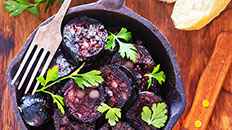Meats and Sausages
Morcela de Cozer de Portalegre
Morcela de Cozer de PortalegreBlood is a Portuguese blood sausage from Portalegre region. Morcela de Cozer de Portalegre carries PGI, 1997 classification.
| Meats | Metric | US |
|---|---|---|
| Fat: neck, butt, belly, jowls, back fat | 700 g | 1.54 lb |
| Blood | 300 g | 10 oz fl |
Ingredients per 1000g (1 kg) of meat
| Salt | 15 g | 2-1/2 tsp |
| Pepper | 2.0 g | 1 tsp |
| Cumin | 2.0 g | 1 tsp |
| Nutmeg | 0.5 g | 1/4 tsp |
| Garlic | 3.5 g | 1 clove |
| Red pepper paste* | 60 g | 2 oz |
| White wine | 60 ml | 2 oz fl |
| Water | 60 ml | 2 oz fl |
Instructions
- Make marinade: wine, water, salt and spices.
- Cut fat into 1/4” (6 mm) cubes. Mix fat with marinade and hold in refrigerator for 12 hours.
- Mix fat, red pepper paste (see below) and blood together.
- Stuff into 36 mm hog casings. Tie the ends together to form a 20” (50 cm) long ring.
- Cook in water at 80° C (176° F) for 45 minutes.
- Immerse sausages in cold water for 5 minutes.
- Cool in air and refrigerate.
Notes
* Red pepper paste (in Portuguese “massa de pimentão”) is an essential condiment in Portuguese cooking.
Home method for making red pepper paste (about 1 cup): 3 red bell peppers, 24 g (4 tsp) salt, 2 cloves of garlic, 1 fl oz (30 ml=2 Tbsp) olive oil. Cut peppers into quarters. Remove the stems and seeds. Remove the white pulp from the inside of the peppers. Place peppers in a jar and sprinkle them with salt. Shake the jar. Leave uncovered for 24 hours at room temperature. Rinse the peppers and pat them dry with paper towel. Spread peppers on a pan and bake them for 20 minutes until the skins are charred and dark.Remove the tray and let the peppers cool. Remove the skins from the peppers, they come off easily. Using mixer blend the peppers with 2 garlic cloves adding gradually olive oil. The mixture should reach the consistency of a fine creamy paste.
Home method for making red pepper paste (about 1 cup): 3 red bell peppers, 24 g (4 tsp) salt, 2 cloves of garlic, 1 fl oz (30 ml=2 Tbsp) olive oil. Cut peppers into quarters. Remove the stems and seeds. Remove the white pulp from the inside of the peppers. Place peppers in a jar and sprinkle them with salt. Shake the jar. Leave uncovered for 24 hours at room temperature. Rinse the peppers and pat them dry with paper towel. Spread peppers on a pan and bake them for 20 minutes until the skins are charred and dark.Remove the tray and let the peppers cool. Remove the skins from the peppers, they come off easily. Using mixer blend the peppers with 2 garlic cloves adding gradually olive oil. The mixture should reach the consistency of a fine creamy paste.


















